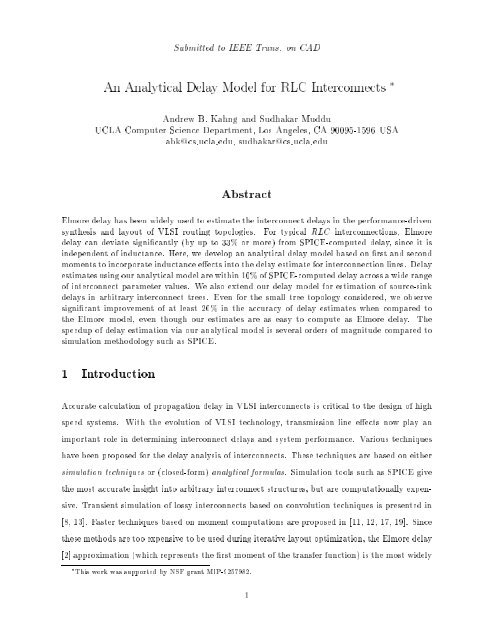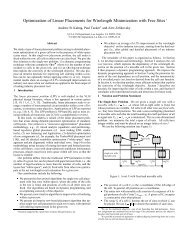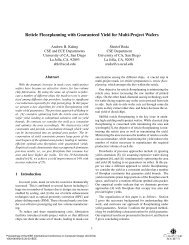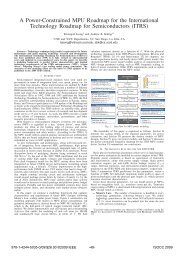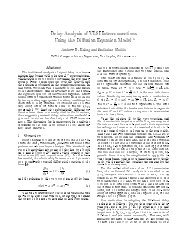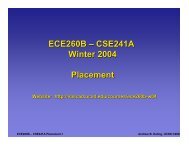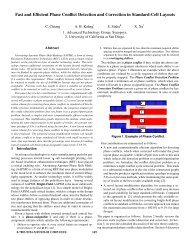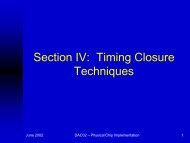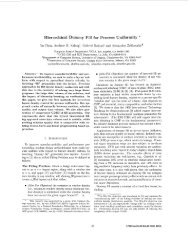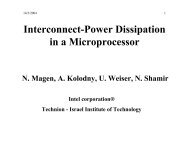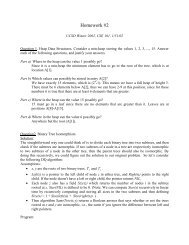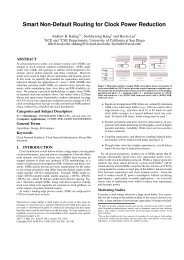An Analytical Delay Model for RLC Interconnects - UCSD VLSI CAD ...
An Analytical Delay Model for RLC Interconnects - UCSD VLSI CAD ...
An Analytical Delay Model for RLC Interconnects - UCSD VLSI CAD ...
Create successful ePaper yourself
Turn your PDF publications into a flip-book with our unique Google optimized e-Paper software.
Submitted to IEEE Trans. on <strong>CAD</strong><br />
<strong>An</strong> <strong>An</strong>alytical <strong>Delay</strong> <strong>Model</strong> <strong>for</strong> <strong>RLC</strong> <strong>Interconnects</strong> <br />
<strong>An</strong>drew B. Kahng and Sudhakar Muddu<br />
UCLA Computer Science Department, Los <strong>An</strong>geles, CA 90095-1596 USA<br />
abk@cs.ucla.edu, sudhakar@cs.ucla.edu<br />
Abstract<br />
Elmore delay has been widely used to estimate the interconnect delays in the per<strong>for</strong>mance-driven<br />
synthesis and layout of <strong>VLSI</strong> routing topologies. For typical <strong>RLC</strong> interconnections, Elmore<br />
delay can deviate signicantly (by up to 33% or more) from SPICE-computed delay, since it is<br />
independent of inductance. Here, we develop an analytical delay model based on rst and second<br />
moments to incorporate inductance eects into the delay estimate <strong>for</strong> interconnection lines. <strong>Delay</strong><br />
estimates using our analytical model are within 10% of SPICE-computed delay across a wide range<br />
of interconnect parameter values. We also extend our delay model <strong>for</strong> estimation of source-sink<br />
delays in arbitrary interconnect trees. Even <strong>for</strong> the small tree topology considered, we observe<br />
signicant improvement of at least 20% in the accuracy of delay estimates when compared to<br />
the Elmore model, even though our estimates are as easy to compute as Elmore delay. The<br />
speedup of delay estimation via our analytical model is several orders of magnitude compared to<br />
simulation methodology such as SPICE.<br />
1 Introduction<br />
Accurate calculation of propagation delay in <strong>VLSI</strong> interconnects is critical to the design of high<br />
speed systems. With the evolution of <strong>VLSI</strong> technology, transmission line eects now play an<br />
important role in determining interconnect delays and system per<strong>for</strong>mance. Various techniques<br />
have been proposed <strong>for</strong> the delay analysis of interconnects. These techniques are based on either<br />
simulation techniques or (closed-<strong>for</strong>m) analytical <strong>for</strong>mulas. Simulation tools such as SPICE give<br />
the most accurate insight into arbitrary interconnect structures, but are computationally expensive.<br />
Transient simulation of lossy interconnects based on convolution techniques is presented in<br />
[8, 13]. Faster techniques based on moment computations are proposed in [11, 12,17,19]. Since<br />
these methods are too expensive to be used during iterative layout optimization, the Elmore delay<br />
[2] approximation (which represents the rst moment of the transfer function) is the most widely<br />
This work was supported by NSF grant MIP-9257982.<br />
1
*** DO NOT PROPAGATE this draft or in<strong>for</strong>mation contained within ***<br />
used delay model in the per<strong>for</strong>mance-driven design of clock distribution and Steiner global routing<br />
topologies. However, Elmore delay cannot accurately estimate the delay <strong>for</strong> <strong>RLC</strong> interconnect<br />
lines, i.e., the representation <strong>for</strong> interconnects whose inductive impedance 1 cannot be neglected<br />
[4]. To see the eect of inductance impedance on the response, consider a 2-port model <strong>for</strong> an<br />
interconnect driven by a step input with nite source impedance. Figure 1 compares the RC and<br />
<strong>RLC</strong> line responses computed by SPICE3e: 90% threshold delay is288ps <strong>for</strong> the <strong>RLC</strong> model,<br />
but is 358 ps <strong>for</strong> the RC model. Elmore delay, which does not depend on line inductance, will<br />
yield the same delay estimate of 386 ps <strong>for</strong> both the RC and the <strong>RLC</strong> cases. More generally, the<br />
Elmore delay <strong>for</strong>mula gives good estimates if the interconnect lines are RC or overdamped, but<br />
gives overestimates <strong>for</strong> <strong>RLC</strong> or underdamped interconnects. This inaccuracy can be harmful <strong>for</strong><br />
current per<strong>for</strong>mance-driven routing methods which try to optimize interconnect segment lengths<br />
and widths (as well as drivers and buers).<br />
<strong>RLC</strong> <strong>Model</strong><br />
RC <strong>Model</strong><br />
Figure 1: Comparison of SPICE3e responses at the end of an interconnect line driven by a<br />
step input and terminated with a capacitive load using both RC and <strong>RLC</strong> 2-port models.<br />
The 90% threshold delay <strong>for</strong> the <strong>RLC</strong> modelis288ps, and <strong>for</strong> the RC model the delay is<br />
358 ps. The driver resistance is 10:0 and the load capacitance at the end of the line is 2:0<br />
pF . The interconnect line parameters are R =0:075 =m, L =0:123 pH=m, C =8:8<br />
fF=m; the length of the line is 400 m.<br />
This paper gives a new and accurate analytical delay estimate <strong>for</strong> distributed <strong>RLC</strong> interconnects<br />
which considers the eect of inductance. Previous moment-based approaches (e.g.,<br />
1 Inductive impedance is 2fL, wheref is the frequency of operation.<br />
2
*** DO NOT PROPAGATE this draft or in<strong>for</strong>mation contained within ***<br />
[9, 11,8]) can compute a delay estimate only from a simulated response but not from an analytical<br />
<strong>for</strong>mula. To experimentally validate our analysis and delay <strong>for</strong>mula, we model <strong>VLSI</strong><br />
interconnect lines having various combinations of source and load parameters, and obtain delay<br />
estimates from SPICE, Elmore delay and the proposed analytical delay model. The delay estimate<br />
using SPICE is extracted from a computed response at the desired node, whereas the other<br />
two models are analytical (closed-<strong>for</strong>m) expressions. Over our range of test cases, Elmore delay<br />
estimates can be as much as 50% from the SPICE-computed delays, while our analytical delay<br />
model estimates are within 15% of SPICE delays. We also extend our delay model to estimate<br />
source-sink delays in arbitrary interconnect trees. For the small tree topology considered, delay<br />
estimates using our analytical model are within 15% of SPICE-computed delays. While Elmore<br />
delay estimates vary by asmuch as 35% from the SPICE-computed delays. Since our analytical<br />
model has the same time complexity as the Elmore model, we believe that it can be useful in<br />
present-day per<strong>for</strong>mance-driven routing methodologies.<br />
The organization of our paper is as follows. In Section 2 we discuss previous analytical delay<br />
models <strong>for</strong> distributed interconnect lines. Section 3 presents a new analytical delay model model<br />
<strong>for</strong> a distributed <strong>RLC</strong> line, and nally Section 4 extends our delay model <strong>for</strong> interconnection<br />
trees.<br />
2 Previous <strong>An</strong>alytic <strong>Delay</strong> <strong>Model</strong>s<br />
The transfer function of an <strong>RLC</strong> interconnect line with source and load impedance (Figure 2)<br />
can be obtained using the ABCD parameters [1] as<br />
H(s) = V 2(s)<br />
V 0 (s) = 1<br />
h i cosh(h)+<br />
Z S<br />
Z 0<br />
sinh(h) + 1<br />
Z T<br />
where = p (r + sl)sc is the propagation constant andZ 0 =<br />
impedance; r = R h ;l = L h ;c = C h<br />
[Z 0 sinh(h)+Z S cosh(h)]<br />
q<br />
R+sL<br />
sC<br />
(1)<br />
is the characteristic<br />
are resistance, inductance, and capacitance per unit length<br />
and h is the length of the line. To compute the <strong>RLC</strong> line response from the transfer function, the<br />
method of Pade approximation has been used by, e.g., [9, 10]. The output transfer function is<br />
expanded into a Maclaurin series of s around s = 0, and the series is truncated to desired order. 2<br />
2 The work of [8] used a recursive convolution based approach and expanded the admittance and the propagation<br />
coecient term around s = 1.<br />
3
*** DO NOT PROPAGATE this draft or in<strong>for</strong>mation contained within ***<br />
In general, analytical computation of the exact voltage response is very tedious and is usually in<br />
the <strong>for</strong>m of an innite series.<br />
ZS<br />
Distributed <strong>RLC</strong> line<br />
v (t) i (t)<br />
v (t) i (t)<br />
0 0 1 1<br />
i (t) v (t)<br />
2 2<br />
Z T<br />
Figure 2: 2-port model of a distributed <strong>RLC</strong> line with source impedance Z S<br />
impedance Z T .<br />
and load<br />
Ecient delay estimates <strong>for</strong> RC lines are typically derived by considering a single interconnect<br />
line with resistive source and capacitive load impedances; delay <strong>for</strong>mulas <strong>for</strong> an interconnect tree<br />
entail recursive application of the <strong>for</strong>mula <strong>for</strong> a single line. The analytical Elmore delay [2]<br />
estimate, Sakurai's heuristical delay <strong>for</strong>mula [15, 16] and single pole delay estimates of [3] have<br />
been widely used.<br />
Elmore delay is dened to be the rst moment of the system impulse response, i.e., the<br />
coecient ofs or the rst moment in the system transfer function H(s). Applying this<br />
denition to H(s) in Equation (1) and considering a source resistance R S and a capacitive<br />
load C T , the Elmore delay <strong>for</strong> a distributed RC or <strong>RLC</strong> line model is<br />
T ED = R S (C + C T )+R( C 2 + C T ) (2)<br />
By considering only one pole in the transfer function, i.e, approximating the denominator<br />
polynomial to only rst moment, the single pole response can be obtained as in [3]. The<br />
single pole of the transfer function is equal to the inverse of the Elmore delay T ED . Hence,<br />
the delay at arbitrary thresholds of the single pole response can be directly related to Elmore<br />
delay (Elmore delay actually corresponds to the 63:2% threshold voltage of the single pole<br />
response). For example, delay at 90% threshold voltage is<br />
T 0:9 = 2:3 T ED =1:15RC +2:3(R S (C + C T )+RC T ) (3)<br />
Sakurai [15] alsogave response and delay calculations <strong>for</strong> the distributed RC line. He calculates<br />
the time-domain response from the transfer function using the Heaviside expansion<br />
4
*** DO NOT PROPAGATE this draft or in<strong>for</strong>mation contained within ***<br />
over poles of the transfer function. Then, he approximates the response using a single pole<br />
and observes the variation of delay with respect to source and load parameters; a 90%<br />
threshold delay estimate is heuristically obtained as<br />
T 0:9 (h) =1:02RC +2:3(R S (C + C T )+RC T )<br />
Note that Sakurai's heuristic delay <strong>for</strong>mula is almost identical to the Elmore delay equation (3).<br />
In this paper, to compute the 90% threshold delay according to the Elmore model we apply<br />
Equation (3). Since these single pole delay estimates cannot accurately estimate delay <strong>for</strong> <strong>RLC</strong><br />
interconnects, Zhou et al. [19] proposedatwo-pole approximation <strong>for</strong> the transfer function to<br />
compute the response at the load <strong>for</strong> <strong>RLC</strong> interconnection trees. However, this technique is<br />
based on response computation and does not provide any analytical expression <strong>for</strong> delay; it is too<br />
time-consuming to be used in iterative optimization of layout. Recently, [7] proposed to improve<br />
the Elmore delay model by using higher-order moments; this work gave a heuristic net delay<br />
model equal to the sum of the rst moment (M 1 ) and its standard deviation. 3<br />
3 A New <strong>An</strong>alytical <strong>Delay</strong> <strong>Model</strong><br />
We nowdevelop a simple closed-<strong>for</strong>m delay estimate, based on rst and second moments, which<br />
considers the eect of inductance.<br />
To our knowledge, this is the rst analytical delay model<br />
which handles arbitrary threshold voltages and inductance eects <strong>for</strong> a distributed line. We give<br />
experimental conrmation via 90% threshold delay estimates 4 which we compare against SPICE<br />
output. 5<br />
We model an arbitrary interconnect line as follows: (i) the source is modeled as a resistive<br />
and inductive impedance (Z S = R S + sL s ), and (ii) the load at the end of the interconnect line<br />
is modeled using capacitive impedance. Thus, the transfer function <strong>for</strong> the interconnect line of<br />
p 3 Standard deviation is equal to = jM1 2 , M2j. In the early drafts of our paper [6] we also considered exactly<br />
the same model; however, it turns out that this model is not accurate <strong>for</strong> various source and load parameters, as<br />
discussed in detail by [6]. The full version of our paper [6] studies various combinations of rst and second moments,<br />
of which the analytical model described here per<strong>for</strong>ms best.<br />
4 Our analytical model extends to any threshold delays; we simply give the derivation <strong>for</strong> 90% delay threshold.<br />
5 SPICE simulation results are obtained using SPICE3 and the built-in LTRA (lossy transmission line) model,<br />
which is based on convolution techniques [13].<br />
5
*** DO NOT PROPAGATE this draft or in<strong>for</strong>mation contained within ***<br />
S<br />
R<br />
S<br />
L<br />
S<br />
A B T<br />
Distributed <strong>RLC</strong> line<br />
v (t) i (t) v (t) i (t)<br />
0 0 1 1<br />
i (t)<br />
2 v 2<br />
(t)<br />
C T<br />
Figure 3: 2-port model of a distributed <strong>RLC</strong> line with resistive and inductive source<br />
impedance, and capacitive load impedance.<br />
Figure 3 is<br />
H(s) =<br />
where Z T = 1<br />
sC T<br />
, Z S = R S + sL S , Z 0 =<br />
cosh(h) 1+ Z S<br />
Z T<br />
<br />
+ sinh(h)<br />
<br />
ZS<br />
Z 0<br />
+ Z 0<br />
q<br />
R+sL<br />
sC<br />
1<br />
Z T<br />
<br />
and h = p (R + sL)sC. We truncate this<br />
transfer function by expanding the hyperbolic functions around s = 0; expansion around s = 1<br />
is not necessary since we consider only the rst few coecients of the transfer function. I.e.,<br />
expanding cosh and sinh as innite series and collecting terms up to the coecient ofs 2 in the<br />
denominator, we obtain the truncated transfer function<br />
H(s) <br />
1<br />
1+sb 1 + s 2 b 2<br />
with coecients<br />
b 1 = R S C + R I C T + RC 2 + RC T<br />
b 2 = R SRC 2<br />
6<br />
+ R SRCC T<br />
2<br />
+ (RC)2<br />
24<br />
+ R2 CC T<br />
6<br />
+ L S C + L S C T + LC 2 + LC T (4)<br />
Note that the rst and second moments of the transfer function can be obtained from the coef-<br />
cients b 1 and b 2 , i.e., M 1 = b 1 and M 2 = b 2 , b 1 2.We use the coecient notation b 1 ;b 2 and the<br />
moment notation M 1 ;M 2 interchangeably according to the simplicity of the expression. Depending<br />
on the sign of b 2 , 4b 1 2, the poles of the transfer function can be either real or complex. We<br />
separately derive our delay model from the two-pole response <strong>for</strong> each of these cases.<br />
Real Poles:<br />
The two-pole methodology [6, 19] yields the following response <strong>for</strong> the case of real poles:<br />
v(t) =V 0 (1 , s 2<br />
s 2 , s 1<br />
e s 1t + s 1<br />
s 2 , s 1<br />
e s 2t )<br />
6
*** DO NOT PROPAGATE this draft or in<strong>for</strong>mation contained within ***<br />
Source Load <strong>Delay</strong> from <strong>An</strong>alytical <strong>Delay</strong><br />
Response <strong>Model</strong>s<br />
R S L S C T SPICE Elmore New <strong>Model</strong><br />
pH pF ps ps ps<br />
50 2.46 0.176 22.33 22.93 22.21<br />
100 2.46 0.176 45.30 45.20 45.70<br />
500 2.46 0.176 224.50 223.50 228.95<br />
1000 2.46 0.176 446.20 446.4 457.46<br />
25 2.46 1.76 107.10 108.40 108.65<br />
50 2.46 1.76 210.10 210.80 214.74<br />
100 2.46 1.76 415.20 415.40 425.10<br />
500 2.46 1.76 2052.60 2053.0 2103.68<br />
1000 2.46 1.76 4099.50 4100.0 4101.30<br />
Table 1: 90% threshold voltage delay estimates <strong>for</strong> combinations of source and load parameters<br />
<strong>for</strong> which the poles of the response are real (i.e., overdamped response). The interconnect<br />
line parameters are R =0:015 =m, L =0:246 pH=m and C =0:176 fF=m and the<br />
length of the interconnect is 100 m.<br />
where<br />
s 1;2 =<br />
,M 1 <br />
2<br />
q<br />
4M 2 , 3M 2 1<br />
q<br />
= ,b 1 b 2 , 4b 1 2<br />
2b 2<br />
The condition <strong>for</strong> the poles to be real is (4M 2 , 3M 2 1<br />
)=(b 2 1<br />
, 4b 2 ) 0. Since s 2 , s 1 = ,<br />
is negative, the coecients<br />
s 2<br />
s 2 ,s 1<br />
and s 1<br />
s 2 ,s 1<br />
p<br />
b 2 1 ,4b 2<br />
b 2<br />
are positive. Also, since the magnitude js 2 j is greater<br />
than js 1 j, the second term in the time-domain response decreases rapidly compared to the rst<br />
term. Hence, the two-pole response can be approximated (lower-bounded) as<br />
v(t) V 0 (1 , s 2<br />
s 2 , s 1<br />
e s 1t )<br />
Since the voltage is lower-bounded, the delay obtained is an upper bound on the actual delay. The<br />
delay r (the subscript indicates the case of real poles) at threshold voltage v th can be obtained<br />
via<br />
Letting K r =ln<br />
<br />
(s2 , s 1 )(1 , v th )<br />
s 1 r =ln<br />
<br />
s 2<br />
1<br />
[1 + p<br />
b 1<br />
2(1,v th )<br />
b 2 1 ,4b 2<br />
r = K r<br />
js 1 j = K M 1 +<br />
r<br />
<br />
<br />
] ,wehave<br />
0<br />
= , ln @<br />
1<br />
2(1 , v th ) [1 + b<br />
q<br />
1<br />
]<br />
b 2 , 4b 1 2<br />
q<br />
4M 2 , 3M 2 1<br />
2<br />
q<br />
2b 2<br />
= K r<br />
b 1 , b 2 , 4b 1 2<br />
1<br />
A<br />
7
*** DO NOT PROPAGATE this draft or in<strong>for</strong>mation contained within ***<br />
i.e., K r is a function of the coecients b 1 and b 2 . For the wide range of source, load and<br />
interconnect parameter values considered in our simulations (see Table 1), we nd that K r<br />
actually almost a constant: the plot on the left side of Figure 4 shows the linear regression used<br />
to nd the value K r =2:36 which givesavery strong t between SPICE delay values and 1<br />
js 1 j .<br />
The variation of K r with the quantity X = b 2<br />
b 2 1<br />
r =2:36 <br />
b 1 ,<br />
2b<br />
q 2<br />
b 2 , 4b 1 2<br />
is further discussed in [6]. Thus, we use<br />
=2:36 (M 1 +<br />
q<br />
4M 2 , 3M 2)<br />
1<br />
; (5)<br />
2<br />
the resulting delay estimates are compared against those of various other methods in Table 1.<br />
We see that our analytical delay model gives estimates close to those obtained from SPICE, but<br />
as expected Elmore delay also gives good estimates <strong>for</strong> this case where the interconnect response<br />
is overdamped.<br />
is<br />
500<br />
10<br />
450<br />
9<br />
400<br />
8<br />
SPICE <strong>Delay</strong> (ps)<br />
350<br />
300<br />
250<br />
200<br />
150<br />
SPICE <strong>Delay</strong> (ps)<br />
7<br />
6<br />
5<br />
4<br />
3<br />
100<br />
2<br />
50<br />
0<br />
0 20 40 60 80 100 120 140 160 180 200<br />
1/s1<br />
1<br />
0<br />
0 1 2 3 4 5 6<br />
1/β<br />
Figure 4: The plot on the left shows the strong linear t between SPICE delay and 1<br />
js 1 j<br />
<strong>for</strong><br />
real poles with K r =2:36. The plot on the right shows the strong linear t between SPICE<br />
delay and 1 <strong>for</strong> complex poles with K c =1:66.<br />
Complex Poles<br />
The condition <strong>for</strong> complex poles is (4M 2 , 3M 2 1 )=(b2 1 , 4b 2) 0. The time-domain response<br />
<strong>for</strong> complex poles is given by<br />
p !<br />
2 + <br />
v(t) =V 0 1 ,<br />
2<br />
e ,t sin(t + )<br />
<br />
p<br />
M<br />
where = 1<br />
3M<br />
=<br />
2(M<br />
1 2 1 2 ,4M 2<br />
and = tan ,1 ( ). Using the above equation and threshold<br />
,M 2) 2(M<br />
1 2 ,M 2) <br />
8
*** DO NOT PROPAGATE this draft or in<strong>for</strong>mation contained within ***<br />
voltage v th ,weget<br />
e ,t sin( t + ) =<br />
1 , v th<br />
q<br />
1+(<br />
<br />
)2 (6)<br />
The delay atagiven threshold voltage can be computed by solving <strong>for</strong> time in Equation (6)<br />
recursively. One way to solve the recursive Equation (6) is to approximate the time variable in<br />
the exponential term by Elmore delay, i.e., substitute T ED <strong>for</strong> time t. Expanding sine as a Taylor<br />
series and considering only the rst term yields<br />
There<strong>for</strong>e,<br />
where K c =<br />
e ,T ED<br />
sin( c + ) e ,T ED<br />
( c + ) =<br />
c = K c<br />
<br />
1 , v th<br />
q<br />
1+(<br />
<br />
)2<br />
<br />
<br />
(1,v th )e T ED<br />
, . Substituting <strong>for</strong> and using M p1+( 1 = b 1 and M 2 = b 2 , b<br />
)2 1 2, our<br />
delay estimate is given by<br />
c = K c<br />
<br />
= K 2b 2<br />
c q<br />
4b 2 , b 2 1<br />
Even though K c is function of b 1 and b 2 , <strong>for</strong> a wide range of interconnect, source, and load<br />
parameters it too is almost a constant. We determined the constant value K c =1:66 again by<br />
nding a good t between SPICE delay values and 1 ,asshown on the right side of Figure 4.<br />
<br />
There<strong>for</strong>e, the 90% threshold delay estimate <strong>for</strong> complex poles is<br />
c =1:66 q<br />
2b 2<br />
2(M<br />
=1:66 1<br />
, M 2 )<br />
q<br />
4b 2 , b 2 1<br />
3M 2 , 4M 1 2<br />
: (7)<br />
Table 2 shows delay values <strong>for</strong> various combinations of source, load and interconnect parameters<br />
assuming the value of K c obtained by this regression analysis. The delay estimates using<br />
our analytical model are within 10% of SPICE-computed delay estimates, while Elmore delay<br />
estimates vary by asmuch as 33% from SPICE-computed delays. Hence, <strong>for</strong> the case of complex<br />
poles (i.e., underdamped response), the Elmore model is no longer acceptably accurate. Last, we<br />
consider the special case in which poles are equal, i.e., a double pole conguration.<br />
Double Poles<br />
The condition <strong>for</strong> a double pole is (b 2 1<br />
, 4b 2 ) = 0. The double-pole response is<br />
V (s) = V 0<br />
s<br />
1<br />
1+b 1 s + b 2 s = V 0<br />
2 s<br />
1<br />
b 2 (s , s 1 ) 2 = V 0<br />
9<br />
1<br />
s , 1<br />
s , s 1<br />
, 2 b 1<br />
1<br />
(s , s 1 ) 2
*** DO NOT PROPAGATE this draft or in<strong>for</strong>mation contained within ***<br />
Source Load <strong>Delay</strong> from <strong>An</strong>alytical <strong>Delay</strong><br />
Response <strong>Model</strong>s (% error)<br />
R S L S C T SPICE Elmore New <strong>Model</strong><br />
pH pF ps ps ps<br />
10 0.0246 0.0176 1.22 0.90 (26%) 1.30 (6%)<br />
15 0.0246 0.0176 1.33 1.31 ( 2%) 1.38 ( 4%)<br />
20 0.0246 0.0176 1.47 1.71 ( 16%) 1.51 ( 3%)<br />
25 0.0246 0.0176 1.60 2.12 ( 33%) 1.64 ( 3%)<br />
10 0.0246 0.176 4.50 5.12 ( 14%) 4.25 ( 6%)<br />
15 0.0246 0.176 5.85 7.32 ( 25%) 5.31 ( 9%)<br />
20 0.0246 0.176 7.90 9.55 (21 %) 8.60 ( 7%)<br />
10 2.46 0.0176 1.31 0.90 ( 31%) 1.40 ( %)<br />
15 2.46 0.0176 1.40 1.31 ( 7%) 1.49 ( 7%)<br />
20 2.46 0.0176 1.55 1.71 ( 10%) 1.59 ( 2%)<br />
25 2.46 0.0176 1.63 2.12 ( 30%) 1.69 ( 4%)<br />
10 2.46 0.176 4.65 5.10 ( 10%) 4.30 ( 8%)<br />
15 2.46 0.176 5.85 7.33 ( 25%) 5.30 ( 9%)<br />
20 2.46 0.176 7.98 9.55 ( 19%) 8.70 ( 9%)<br />
10 24.6 0.0176 1.80 0.90 ( 50%) 1.96 ( 9%)<br />
15 24.6 0.0176 1.89 1.31 ( 31%) 2.06 ( 9%)<br />
20 24.6 0.0176 2.00 1.71 ( 15%) 2.15 ( 7%)<br />
25 24.6 0.0176 2.19 2.11 ( 4%) 2.21 ( 1%)<br />
10 24.6 0.176 5.65 5.10 ( 10%) 5.44 ( 4%)<br />
15 24.6 0.176 6.50 7.33 ( 13%) 5.95 ( 8%)<br />
20 24.6 0.176 7.66 9.55 ( 25%) 6.97 ( 9%)<br />
25 24.6 0.176 9.47 11.78 ( 24%) 9.26 ( 2%)<br />
Table 2: 90% threshold voltage delay estimates <strong>for</strong> the combinations of source and load parameters<br />
<strong>for</strong> which the poles of the response are complex (i.e., underdamped congurations).<br />
The interconnect line parameters are R =0:015 =m, L =0:246 pH=m and C =0:176<br />
fF=m and the length of the interconnect is 100 m. The percentage error of each delay<br />
model with respect to SPICE is also given.<br />
where s 1 = , b 1<br />
2b 2<br />
, and the time-domain response is given by v(t) =V 0<br />
<br />
1 , e<br />
ts 1<br />
, 2t<br />
b 1<br />
e ts 1<br />
. The<br />
delay at 90% threshold is<br />
0:9 = 2b 2<br />
b 1<br />
which gives a recursive equation <strong>for</strong> K d , i.e.,<br />
K d =ln<br />
<br />
ln 10(1 + 2T <br />
0:9 2b 2 b 1<br />
) = K d = K d<br />
b 1 b 1 2<br />
<br />
10(1 + 2T 0:9<br />
b 1<br />
<br />
=ln(10(1 + K d ))<br />
10
*** DO NOT PROPAGATE this draft or in<strong>for</strong>mation contained within ***<br />
from which K d 3:9. Thus, in the case of a double pole the 90% threshold delay is estimated as<br />
0:9 = K d b 1<br />
2 =1:95b 1 (8)<br />
which is independent of the inductance value and dierent from the Elmore delay expression.<br />
I3<br />
N4<br />
I2<br />
N3<br />
I4<br />
N5<br />
I6<br />
N7<br />
N1<br />
I1<br />
N2<br />
I5<br />
N6<br />
I7<br />
N8<br />
I8<br />
N9<br />
Figure 5: A simple interconnection tree consisting of distributed <strong>RLC</strong> lines. The lengths<br />
of the various interconnects are given in Table 3.<br />
4 Interconnection Trees<br />
Finally, wenow describe the extension of our analytical model to estimate delays in arbitrary<br />
interconnect trees. <strong>An</strong> <strong>RLC</strong> network is called an <strong>RLC</strong> tree if it does not contain a closed path<br />
of resistors and inductors, i.e., all resistors and inductors are oating with respect to ground and<br />
all capacitors are connected to ground. Consider an <strong>RLC</strong> interconnect tree with root (or source)<br />
S and set of sinks (or leafs) L = fL 1 ;L 2 ;:::;L n g. The unique path from root S to the sink node<br />
i is denoted by p(i) and is referred as the main path. The edges/nodes not on the main path are<br />
referred as the o-path edges/nodes. We model each edge on the main path of the tree using a<br />
lumped <strong>RLC</strong> segment, e.g., an L, T, or model. We replace the o-path subtree rooted at node<br />
k with the total subtree capacitance at node k. (Figure 6 shows an example of a main path where<br />
each branch in the tree is replaced by <strong>RLC</strong> segments, and the o-path subtrees are replaced by<br />
their respective subtree capacitances.) Hence, at any nodek the total capacitance is given by<br />
11
*** DO NOT PROPAGATE this draft or in<strong>for</strong>mation contained within ***<br />
Interconnect<br />
Length<br />
m<br />
I1 50<br />
I2 100<br />
I3 50<br />
I4 200<br />
I5 100<br />
I6 50<br />
I7 100<br />
I8 200<br />
Table 3: The length of various interconnects in the tree of Figure 5.<br />
C 0 k<br />
= C k if no o-path subtree at node k<br />
= C k + C T (k) if node K has o-path subtree T (k)<br />
where C k is the capacitance at the node and C T (k) is the o-path subtree capacitance at node<br />
k. The k th coecient b k of the transfer function <strong>for</strong> the general <strong>RLC</strong> circuit of Figure 6 can be<br />
expressed using the following recursive equation [5]:<br />
b N +1<br />
k<br />
= R N<br />
N X<br />
j=1<br />
C 0 j b j k,1 + L N<br />
NX<br />
j=1<br />
C 0 j b j k,2 + bN k (9)<br />
where b N K refers to the coecient ofsk in the transfer function between node k and node 1. Note<br />
that b j 0 =1,bj ,1 =0<strong>for</strong>allj and b1 k<br />
= 0 <strong>for</strong> all k. Using the above recursive equation the<br />
expressions <strong>for</strong> the rst and second coecients of the transfer function can be derived as<br />
b N +1<br />
1<br />
= R N<br />
N X<br />
j=1<br />
C 0 j + b N 1<br />
=<br />
b N +1<br />
2<br />
= R N<br />
N X<br />
j=1<br />
C 0 jb j 1 + L N<br />
=<br />
NX<br />
NX<br />
X<br />
NX<br />
i=1<br />
NX<br />
j=1<br />
X<br />
j,1 j,1<br />
C 0 j<br />
R l C 0 j<br />
j=2 l=j i=1 d=i<br />
R i<br />
iX<br />
j=1<br />
C 0 j + b N 2<br />
R d +<br />
C 0 j<br />
NX<br />
NX<br />
C 0 j<br />
j=1 l=j<br />
L l (10)<br />
For any given source and sink pair the coecients b 1 and b 2 can be computed in linear time<br />
by traversing the main path and using the above recursive equation. Using the analytical delay<br />
model developed in the previous section, we can obtain a analytical delay estimate <strong>for</strong> <strong>RLC</strong><br />
12
*** DO NOT PROPAGATE this draft or in<strong>for</strong>mation contained within ***<br />
R S<br />
V R L V R L<br />
V V R L<br />
N+1<br />
N N N N-1 N-1 N-1<br />
2 1 1<br />
S<br />
C’ C’ C’<br />
V<br />
1<br />
T<br />
N N-1<br />
1<br />
C T<br />
Figure 6: Representation of the main path in the tree, where each distributed line is modeled<br />
using <strong>RLC</strong> segments.<br />
interconnect trees using the rst and second coecients. Thus, the 90% threshold delay ata<br />
given sink i, depending on the value of (4M 2 , 3M 2 1<br />
), is<br />
p<br />
= K r (M 1+ 4M 2 ,3M1 2 )<br />
<strong>for</strong> Real poles<br />
2<br />
2(M<br />
T ND (i)<br />
1<br />
= K c <br />
2 ,M 2)<br />
<strong>for</strong> Complex poles<br />
p<br />
3M 2 1 ,4M 2<br />
= K d M 1<br />
2<br />
<strong>for</strong> Double poles<br />
(11)<br />
where the rst and second moments are expressed as M 1 = b 1 and M 2 = b 2 , b 1 2. The coecients<br />
of the transfer function are obtained from Equation (10). By contrast, the Elmore delay at<br />
the sink is equal to the rst moment, or the rst coecient b 1 of the transfer function of the<br />
source-sink main path [14]. The 90% threshold delay using the rst moment is simply<br />
T ED (i) =2:3 M 1 (12)<br />
which we emphasize can be inaccurate despite its wide use, since it ignores inductance of the<br />
interconnect line.<br />
We evaluate the eect of our analytical model by considering a simple interconnection tree<br />
shown in Figure 5. We consider the sink node N4 <strong>for</strong> delay estimation. Each edge on the main<br />
path between the root and node N4 is replaced by atwo L segment model. 6<br />
We then apply<br />
the above described recursive coecient (or moment) computation <strong>for</strong> the resultant <strong>RLC</strong> circuit<br />
of the main path. The 90% threshold delays according to both the Elmore model and our new<br />
analytical model are computed using Equations (11) and (12). We also compute the delay at<br />
the given sink node using SPICE3e, where each edge of the tree is modeled using the LTRA<br />
6 Our model is not limited to traditional segment models, and indeed we believe the accuracy of our results<br />
would improve ifwe use non-uni<strong>for</strong>m segment models [5, 18] designed to perfectly match the low-order moments<br />
of the distributed <strong>RLC</strong> line.<br />
13
*** DO NOT PROPAGATE this draft or in<strong>for</strong>mation contained within ***<br />
Interconnect Driver Load SPICE Elmore New <strong>Model</strong><br />
parameters res. cap. <strong>Delay</strong> <strong>Delay</strong> <strong>Delay</strong><br />
/m pF ps ps ps<br />
R =0:015 <br />
C =0:176 fF 10 0.02 5.7 6.6 5.0<br />
L =0:246 pH<br />
R =0:0015 <br />
C =0:176 fF 10 0.2 37 26 31<br />
L =2:46 pH<br />
R =0:015 <br />
C =0:176 fF 10 0.2 39 29 32<br />
L =2:46 pH<br />
R =0:0015 <br />
C =0:176 fF 10 2.0 179 238 205<br />
L =2:46 pH<br />
R =0:0015 <br />
C =0:176 fF 10 2.0 231 238 232<br />
L =0:246 pH<br />
R =0:015 <br />
C =0:176 fF 10 2.0 199 270 230<br />
L =2:46 pH<br />
R =0:015 <br />
C =0:176 fF 100 2.0 2419 2361 2367<br />
L =2:46 pH<br />
Table 4: 90% threshold delay values <strong>for</strong> a wide range of interconnect parameters at Node<br />
4 of the tree in Figure 5. We compare SPICE LTRA, and the Elmore model, against our<br />
analytical delay model.<br />
(Lossy Transmission Line) model (with SPICE, we rst compute the response at the sink node<br />
and then obtain the delay <strong>for</strong> 90% threshold voltage). Table 4 presents delay estimates <strong>for</strong> a<br />
range of interconnect parameters, driver resistance values, and sink load capacitance values. The<br />
Elmore delay varies by asmuch as 35% from the SPICE-computed delay. However, our new<br />
model is within 15% of the SPICE delay <strong>for</strong> all examples. <strong>An</strong>other advantages of our model<br />
is due to simulation complexity.<br />
Our delay estimates also require three orders of magnitude<br />
less computation than SPICE, since they have the same time complexity as the Elmore delay<br />
estimate.<br />
14
*** DO NOT PROPAGATE this draft or in<strong>for</strong>mation contained within ***<br />
5 Conclusions<br />
Fast delay estimation methods, as opposed to simulation techniques, are needed <strong>for</strong> incremental<br />
per<strong>for</strong>mance-driven layout synthesis. Elmore delay based estimation methods, although ecient,<br />
cannot accurately estimate the delay <strong>for</strong><strong>RLC</strong> interconnect lines. We have obtained an analytical<br />
delay model, based on rst and second moments of <strong>RLC</strong> interconnection lines, which considers<br />
the eect of inductance. Resulting delay estimates are signicantly more accurate than Elmore<br />
delay. We also extend our delay model to estimate source-sink delays in arbitrary interconnect<br />
trees. Even <strong>for</strong> the small tree topology considered, we observe signicant improvement ofatleast<br />
20% in the accuracy of our delay estimates, compared to the Elmore model. Since our model has<br />
the same time complexity as the Elmore model, we believe it can be valuable in modern iterative<br />
layout synthesis methodologies. Our ongoing work applies our analytical model to delay-driven<br />
routing tree construction, zero-skew routing, and delay estimation in nets spanning multiple<br />
routing layers (i.e., with modeling of vias).<br />
15
References<br />
[1] L. N. Dworsky, Modern Transmission Line Theory and Applications, Wiley, 1979.<br />
[2] W. C. Elmore, \The Transient Response of Damped Linear Networks with Particular Regard to<br />
Wideband Ampliers", Journal of Applied Physics 19, Jan. 1948, pp. 55-63.<br />
[3] M. A. Horowitz, \Timing <strong>Model</strong>s <strong>for</strong> MOS Circuits", PhD Thesis, Stan<strong>for</strong>d University, Jan. 1984.<br />
[4] C. C. Huang and L. L. Wu, \Signal Degradation Through Module Pins in <strong>VLSI</strong> Packaging", IBM<br />
J. Res. and Dev. 31(4), July 1987, pp. 489-498.<br />
[5] A. B. Kahng and S. Muddu, \Two-pole <strong>An</strong>alysis of Interconnection Trees", Proc. IEEE MCMC<br />
Conf., January 1995, pp. 105-110.<br />
[6] A. B. Kahng and S. Muddu, \Accurate <strong>An</strong>alytical <strong>Delay</strong> <strong>Model</strong>s <strong>for</strong> <strong>VLSI</strong> Interconnections", UCLA<br />
CS Dept. TR-950034, Sep. 1995.<br />
[7] B. Krauter, R. Gupta, J. Willis, and L. T. Pileggi, \Transmission Line Synthesis", Proc. 32th<br />
ACM/IEEE Design Automation Conf., June 1995, pp. 358-363.<br />
[8] S. Lin and E. S. Kuh, \Transient Simulation of Lossy Interconnect", Proc. 29th ACM/IEEE Design<br />
Automation Conf., June 1992, pp. 81-86.<br />
[9] S. P. McCormick and J. Allen, \ Wave<strong>for</strong>m Moment Methods <strong>for</strong> Improved Interconnection <strong>An</strong>alysis",<br />
Proc. 27th ACM/IEEE Design Automation Conf., June 1990, pp. 406-412.<br />
[10] L. T. Pillage and R. A. Rohrer, \Asymptotic Wave<strong>for</strong>m Evaluation <strong>for</strong> Timing <strong>An</strong>alysis", IEEE<br />
Trans. on <strong>CAD</strong> 9, Apr. 1990, pp.352-366.<br />
[11] V. Raghavan, J. E. Bracken and R. A. Rohrer, \AWESpice: A General Tool <strong>for</strong> the Accurate and<br />
Ecient Simulation of Interconnect Problems", Proc. 29th ACM/IEEE Design Automation Conf.,<br />
June 1992, pp. 87-92.<br />
[12] C. L. Ratzla, N. Gopal, and L. T. Pillage, \RICE: Rapid Interconnect Circuit Evaluator", Proc.<br />
28th ACM/IEEE Design Automation Conf., June 1991, pp. 555-560.<br />
[13] J. S. Roychowdhury and D. O. Pederson, \Ecient Transient Simulation of Lossy Interconnect",<br />
Proc. 28th ACM/IEEE Design Automation Conf., June 1991, pp. 740-745.<br />
[14] J. Rubinstein, P. Peneld and M. A. Horowitz, \Signal <strong>Delay</strong> inRCTree Networks", IEEE Trans.<br />
on <strong>CAD</strong> 2(3), July 1983, pp. 202-211.<br />
[15] T. Sakurai, \Approximation of Wiring <strong>Delay</strong> in MOSFET LSI", IEEE Journal of Solid-State Circuits,<br />
Aug. 1983, Vol.18, No.4, pp. 418-426.<br />
[16] T. Sakurai, \Closed-Form Expressions <strong>for</strong> Interconnection <strong>Delay</strong>, Coupling, and Crosstalk in<br />
<strong>VLSI</strong>'s", IEEE Trans. on Electron Devices 40, Jan. 1993, pp. 118-124.<br />
[17] M. Sriram and S. M. Kang, \Fast Approximation of The Transient Response of Lossy Transmission<br />
Line Trees", Proc. ACM/IEEE Design Automation Conf., June 1993, pp. 691-696.<br />
[18] Q. Yu and E. S. Kuh, \Exact Moment Matching <strong>Model</strong> of Transmission Lines and Application to<br />
Interconnect <strong>Delay</strong> Estimation", IEEE Trans. <strong>VLSI</strong> Systems 3, June 1995, pp. 311-322.<br />
[19] D. Zhou, S. Su, F. Tsui, D. S. Gao and J. S. Cong, \A Simplied Synthesis of Transmission Lines<br />
with A Tree Structure", Intl. Journal of <strong>An</strong>alog Integrated Circuits and Signal Processing 5, Jan.<br />
1994, pp. 19-30.


